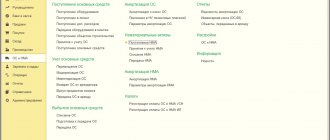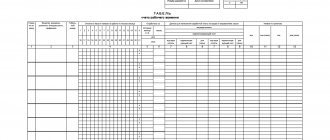Writing off office supplies and documenting them in accounting is an important process, because it is difficult to imagine an organization that has no writing materials at all. Any contact with a client, especially personal, involves signing papers, printing contracts and binding sheets together. Warehouse operations also involve a lot of paperwork. It’s hard to imagine an office without pens, or any office without a seal. But every item fails and ends at some point.
What can be classified as office supplies?
This usually includes all devices that are intended for writing, designing and printing documentation.
Among the main copies:
- pens and pencils;
- felt-tip pens, markers, highlighters;
- paper, white and colored;
- cardboard;
- notebooks, notepads.
Separately, it is worth considering the fastening parts:
- paper clips, staples;
- glue;
- folders, cases, binders.
It is difficult to imagine an enterprise without devices. Among organizational and mechanical equipment:
- typewriters;
- calculators;
- scanner;
- hole puncher;
- stapler
Also, we must not forget about the cabinets in which all this will be stored, about school bags and other types of products that can be attributed to this.
This category contains promotional products that are issued to employees for distribution and use. Everything that is on the balance sheet and has actually already been spent should be written off.
Promotional Products
It happens that in business activities, employees are given stationery for work intended for advertising campaigns of the enterprise (logos and other data of the organization are printed on pens, notepads and other goods). For tax purposes, their cost can also be included as expenses. However, the restrictions provided for certain advertising costs will not apply. (conclusion from the resolution, as an example, FAS Moscow District No. KA-A40/17593-10 dated January 31, 2011).
The costs of office supplies can be taken into account both by companies under the general taxation regime and by “simplified” companies that pay tax on the object according to the “income minus expenses” scheme. The supporting normative act is Art. 346 clause 1 subclause 17 (Tax Code of the Russian Federation).
(Size: 30.0 KiB | Downloads: 6,119) Great article 0
There is hardly a company that does not require printing out any document, putting a signature on it or making a note - all of these actions require the presence of stationery at the enterprise. Sometimes you need a lot of them, sometimes very little, but in any case you need to be able to properly conduct accounting in relation to them. In this article we will talk about postings for writing off paper and stationery, and give an example of drawing up a write-off act.
Stationery supplies are purchased through an accountable person of the company or directly from the supplier. They are accounted for as inventories (inventories) and are reflected in accounts at the purchase price plus delivery costs, VAT is excluded. You also need to write off office supplies according to the rules.
Business Solutions
- shops clothing, shoes, groceries, toys, cosmetics, appliances Read more
- warehouses
material, in-production, sales and transport organizations Read more
- marking
tobacco, shoes, consumer goods, medicines Read more
- production
meat, procurement, machining, assembly and installation Read more
- rfid
radio frequency identification of inventory items More details
- egais
automation of accounting operations with alcoholic beverages Read more
Colleagues found four ways to conveniently record office supplies
But this method is cumbersome and time-consuming, although it provides complete and reliable information about stocks and control over availability and movement. I see the most correct and optimal solution to the problem of accounting for “officework” being dividing them into homogeneous groups. On account 10 “Materials” the group “Stationery” is formed separately.
In the 1C program, I create the “Stationery” group on account 10.6.
The elements of a subgroup are already homogeneous goods. For example, “Ballpoint pen”, “Note block”, “A-4 paper”, “Binder”, “General notebook” and so on. This method is also convenient to use in cases where office supplies are written off not on the day they are registered, but according to employee needs.
Every week, the secretary forms a paper demand invoice according to form No. M-11, according to which a “stationary” is issued.
Order to write off material assets (sample)
In all cases, accounting for such material assets is unprofitable for the organization and entails additional costs.
In addition, failure to write off material assets may become the basis for abuse by persons directly working with material assets. However, in order to directly carry out actions to write off material assets, it is necessary to issue a special act from the manager - an order to write off material assets. Before the manager makes a decision on write-off, a special commission performs its work.
Its composition is approved by order of management and includes, as a rule, the chief accountant, financially responsible persons and other specialists if the write-off requires special knowledge in a certain area.
The tasks of the commission include: inspection of materials; establishing the reasons for their unsuitability for use; identification of the perpetrators; determining the future fate of discarded materials; drawing up an act for writing off materials; submitting the act for approval to an authorized person; estimating the cost of materials; control over the disposal of materials.
Write-off act for office supplies
If the office was purchased with the company's money, then over time it is necessary to write it off in order to buy a new one. The main thing is to fill out this document correctly and comply with all the standards established by the company. Completing this paper is a mandatory part of the procedure; it is a primary accounting form.
Who has the right to use
This is a common form of deregistration, which is actively used by small, medium and large businesses alike, since every enterprise needs to write off office supplies. The tax system does not play a role here.
Why register it?
Quite often, companies that regularly purchase “stationery” classify it as an expense at the time they purchase it. But this is the wrong decision, because the tax service may issue a fine, since in this case the income tax becomes higher. The inspector does not recognize this as expenses that relate to the main activity for no reason.
It is the drawn up document that becomes the reason that justifies the removal of inventory items from the register and allows the amount to be added to the expenses of the enterprise. With its help, it becomes possible to officially reduce the tax base for all expenses of this kind.
Reasons and grounds for writing off office supplies in the act - sample and examples
Many accountants believe that it is easier to carry out such an operation immediately after purchasing a CT scanner. That is, they are brought to the company, the production is noted and immediately attributed to the expenses of the main activity. On the one hand, this way the specialist does not forget to indicate the expenses. But on the other hand, periodic acquisition and constant withdrawal on the same day becomes a violation.
When the inspector conducts an audit of activities, he will recognize this method as incorrect, recalculate and redistribute the balance so that a large amount will have to be paid due to changes in the level of profit.
Therefore, it is worth acting differently. How to write off an office - remove materials according to a pre-planned schedule, which will be established by special order. Another option is to create a manager’s order, in accordance with which responsible persons carry out an inventory.
At what point is it compiled and who will apply it?
This procedure assumes that records were kept from the acquisition of materials to removal from the balance sheet of the enterprise. Therefore, all operations must take place and it is necessary that they follow a certain algorithm.
How this is done:
1. Inventory and materials are received from a supplier or a traveling employee - written by PKO according to f. No. 4;
2. If it is necessary to send goods to a specific department, then indicate the requirement-invoice (form No. 11), which contains the purpose and quantity of products;
3. A document is drawn up and signed, preceded by a management order.
Each enterprise can use such paper for general taxation and for “simplified” taxes. That is, they can remove items from the balance that they previously placed there. But it is important that the CT scans are in a volume that is greater than what is written off. At the time of inventory before drawing up the act, they must also be on the accounts.
It is not advisable to leave all this to chance, since if you do not control the quantities and do not receive inventory items upon receipt, then problems will appear later at the time of write-off, since there is no reason for this. Even if it seems that the cost of the purchased pens is small, it gradually accumulates and it will no longer be possible to remove it from the balance with one operation. The shortages will grow every month. However, reporting will not be possible.
Now there are many different orders and recommendations from the Government that relate to the deregistration of fixed assets and inventory items. Note that it reveals two applications:
1. Reflects the status of the accounts on which the calculation will be carried out;
2. Shows how the budget tool can be used.
In addition, each organization must draw up its own internal regulations, which help regulate the features and order of movement of CT.
So let's write it down
Separately, I would like to touch upon the issue of including some inventories, the useful life of which is more than 12 months, into fixed assets. Mandatory features of fixed assets are given in clause 4 of PBU 6/01 “Accounting for fixed assets”, approved by order of the Ministry of Finance of Russia dated March 30, 2001 No. 26n. Assets that meet all the characteristics of fixed assets, the cost of which does not exceed 40,000 rubles, can be taken into account as part of the inventory (clause 5 of PBU 6/01). This right is fixed in the accounting policy for accounting purposes, indicating the limit on the value of objects with a useful life of more than a year, which will be taken into account as inventory. The limit amount cannot exceed RUB 20,000. (clause 5 of PBU 6/01). Thus, the organization can safely receive scissors and calculators in the Debit of account 10. To fulfill the requirement of paragraph 4 of paragraph 5 of PBU 6/01 on proper control, it will be necessary to organize accounting “behind the balance sheet”.
Business Solutions
- the shops
clothes, shoes, products, toys, cosmetics, appliances Read more
- warehouses
material, in-production, sales and transport organizations Read more
- marking
tobacco, shoes, consumer goods, medicines Read more
- production
meat, procurement, machining, assembly and installation Read more
- rfid
radio frequency identification of inventory items More details
- egais
automation of accounting operations with alcoholic beverages Read more
How to write off office supplies: documentation in a budget institution
It is important here to check what is deregistered and in what quantity, because the tax office will definitely raise questions about 10 calculators every month, which are used by a department of 2 people.
More often, small CTs are purchased for cash or by bank transfer; in the first case, this is usually purchased by an accountable person; in the second, it is transferred to a bank account in favor of the supplier.
It doesn’t matter whether they will be transferred to the warehouse or immediately used by employees, they should be recorded in accounting. For this procedure, a specialist will need:
- invoice;
- cash and sales receipts.
Based on the first document, the accountant will draw up a PQR, which will indicate the names of all CTs that were purchased. Units of measurement and quantities of purchased items are also specified. Enter the financially responsible person who made the purchase and the one to whose warehouse the goods are credited.
The header of the statement will look like this:
| № | Employee's full name | Unit change | Volume | Signature |
It is filled out by the MOL when it is issued from warehouses to people for use. At the end of the month, he closes it, checks actual availability with virtual balances, and transfers it to the accounting department. These papers may be closed at another period if this is established by internal regulations.
Based on this file, the accountant draws up a demand invoice for writing off office supplies. It reflects the general CT issued and is filed with the rest of the documents of the month.
It is worth remembering that if the organization is small and there are not many employees who use CT, then the statement is not required. When the office movement is small, you can immediately use the demand invoice and write off on this basis. In addition, an act is drawn up.
The manager checks the completion and number of specified copies of the CT, looks at the availability of documentation in accounting. If everything is correct, then the costs are included in expenses and are considered written off.
Pencils and pens are thrown away
From the organization's warehouses, office supplies are, as a rule, transferred to separate divisions. At the same time, standard forms of primary accounting documents approved by Decree of the State Statistics Committee of October 30, 1997 No. 71a are drawn up:
- limit-fence card (standard interindustry form No. M-8),
- requirement-invoice (standard interindustry form No. M-11),
- invoice (standard interindustry form No. M-15).
Often, the cost of refilling a cartridge is taken into account by accountants as part of the cost of “office supplies”. However, in letters from the Ministry of Finance of the Russian Federation, these costs are proposed to be taken into account as part of material costs on the basis of paragraphs. 2 p. 1 art. 254 Tax Code of the Russian Federation.
Materials that have served their useful life are written off as an expense report in the department that is their recipient. The document includes the necessary information about the valuables being written off: name, quantity, accounting price and amount for each item, number (code) and (or) name of the order (product, product) for the manufacture of which they were used, or number (code) and (or) the name of the costs, the quantity and amount according to consumption standards, the quantity and amount of consumption in excess of the standards and their reasons; where necessary, the quantity of manufactured products or the volume of work performed is indicated (clause 98 of the Methodological Instructions for Accounting for Inventories, approved by Order of the Ministry of Finance dated December 28, 2001 No. 119n). The procedure for drawing up a materials consumption report, as well as the list of departments for which it is provided, are established by the organization independently. Instead of drawing up an act, you can supplement the demand invoice in form No. M-11 with one more detail that will decipher the purpose of using the “office” and allow you to write off materials as expenses using one modified document. The main thing is that this form of demand-invoice is approved in the accounting policy as a document confirming the consumption of materials.
In accounting, the write-off of inventories as expenses is carried out using one of the methods provided for in paragraph 16 of PBU 5/01: at the cost of each unit, at the average cost, at the cost of the first acquisition of inventories (FIFO method). The choice of the method used is reflected in the accounting policy for accounting purposes (clause 73 of the Guidelines).
Written-off stationery - documentation in the Republic of Belarus (budget discrepancies)
To carry out this operation correctly, you need to enter the following information:
- name of the insurance company;
- the date on which the products were shipped;
- the number of the telephone message indicating that the sender was called, and the date on which it was composed;
- volume of seats;
- what does the packaging look like?
- units in which the measurement is carried out;
- passport ID.
It is worth noting that the contract can specify other papers that will be drawn up if deviations are detected.
What wiring should be
First you need to determine where the materials could go. There are many such paths in every organization; there is always the opportunity to write them off somewhere:
- as a basis for production;
- will become packaging for GP;
- one of the auxiliary consumables for the manufacture of the final product;
- promotes the liquidation of out-of-service fixed assets;
- used by the administration in their activities;
- useful for OS construction.
Depending on what a certain number of handles or cabinets were used for, the wiring data changes:
- Dt 20 – Kt 10 – when raw materials are sent to the production workshop;
- Dt 25 – Kt 10 – materials transferred to the repair department;
- Dt 26 – Dt 10 – the accounting department received office paper;
- Dt 44 – Kt 10 – containers for GP were issued;
- Dt 91-2 – Kt 10 – office supplies are allocated for the liquidation of a certain fixed asset;
- Dt 94 – Kt 10 – the missing (shortage) CTs were written off.
Documents without which stationery and other office expenses cannot be written off
The method you choose should be recorded in the accounting policy in the “Raw Materials” section.
The costs of office supplies can be taken into account both by companies under the general taxation regime and by “simplified” companies that pay tax on the object according to the “income minus expenses” scheme. – In our company, stationery is bought by employees. They often bring checks without decoding. It simply says “Stationery” and the quantity is indicated. How to process such documents? – You can accept stationery for accounting as a unit, without breaking it down into positions. But I repeat, this is risky. The total amount without decoding will not satisfy the tax authorities.
They can challenge the costs. Ask employees to redo the documents.
Feel free to write off office supplies as expenses both in the general system and in the simplified tax system.
Organizations on OSNO account for them as other costs associated with production and sales (). Companies using the simplified tax system are included in expenses after payment on the basis of paragraph 1 of Article 346.16 of the Tax Code of the Russian Federation. Of course, this only applies to those who pay tax on the difference between income and expenses.
What are the stages of purchasing office supplies?
The whole procedure consists of several sequential steps:
- First, a product is purchased, and a cash receipt and sales receipt must be obtained.
- A PKO is drawn up, without which it will not be possible to capitalize the “stationery”.
- Then the purchased items are sent to the warehouse or, in some cases, directly to the requesting department. If the actions were carried out through a warehouse, then a standard form is first drawn up. No. 4, then everything is issued upon request - an invoice with a mandatory mark in the statement.
- The last action of the life of the CT on the territory of the company will be the act of writing off and attributing it to the expenses of the enterprise. Remember that the document can be compiled in free form, this is not a unified paper. But it is better if a template is drawn up within the company according to which everything will happen every time.
We looked at how to correctly write off office supplies so as not to raise questions from the tax authorities and to correctly keep records of all purchased CTs in the organization.
This is necessary to avoid unnecessary losses and costs, because even if it seems that the amount spent on office supplies is minimal, it still needs to be taken into account. Gradually, it accumulates and turns out to be a serious expense item, so we advise you to keep an eye on it. Number of impressions: 14386
BASIS: VAT
Input VAT presented when purchasing stationery can be deducted if you have an invoice (clause 2 of Article 171 of the Tax Code of the Russian Federation). The exception to this rule is when:
- the organization enjoys VAT exemption;
- The organization carries out only VAT-free transactions.
In these cases, include input VAT in the cost of stationery. This follows from paragraph 2 of Article 170 of the Tax Code of the Russian Federation.
If an organization carries out both taxable and non-VAT-taxable operations, distribute the input tax on the cost of stationery (clauses 4 and 4.1 of Article 170 of the Tax Code of the Russian Federation).









